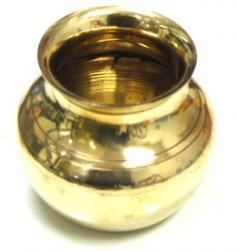 | ||
A lota (Urdu: لوٹا, Hindi: लोटा, Bengali: লোটা) is a small, usually spherical water vessel of brass, copper or plastic used in parts of South Asia for personal hygiene and, among Muslims, for wudu. A similar vessel to the lota is the buta used in Muslim parts of Africa.
Contents
Design example
American designer Charles Eames in his The India Report expressed a great admiration for the lota, saying about its design, "Of all the objects we have seen and admired during our visit to India, the Lota, that simple vessel of everyday use, stands out as perhaps the greatest, the most beautiful."
Yoga and religious uses
The lota is also used in religious activities, like Hindu puja. When used for Hindu worship, it is often decorated with sindoor and/or turmeric powder.
Related concepts
In some parts of Pakistan and India, the use of the phrase "bependi ka lota" (a "lota without a base") is colloquially used to refer to a person who may switch their loyalties. This comes from the observation that a spherical lota without a base tends to roll over in unpredictable directions when kept on uneven ground. The neologism "lotacracy" was coined in Pakistan to describe politicians who would switch parties.
Cleansing
In Islam, the wudu and ghusl ritual purification require water, for which a lota is commonly used.
In the Indian subcontinent, the lota is employed to cleanse oneself. In parts of Bangladesh the term "bodna" describes spouted (teapot-like) vessels. People of the desi diaspora may use watering cans, empty bottles or cups for this purpose. Muslims often refer to the cleansing process as istinja.
This 'bodna' is used by Hindus and called Gangasagar. It is often used for serving water/ sharbat to people in a party or Barat or langar.
